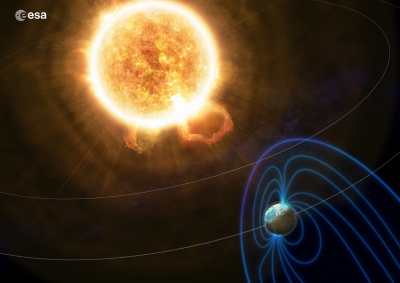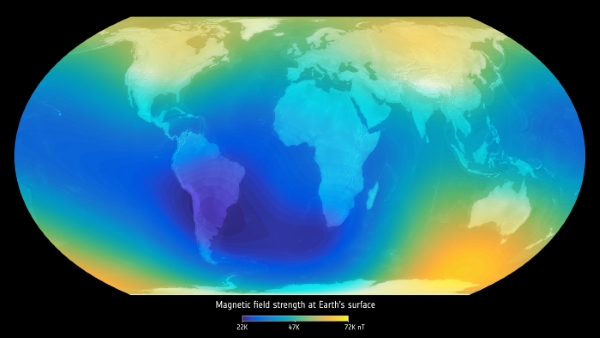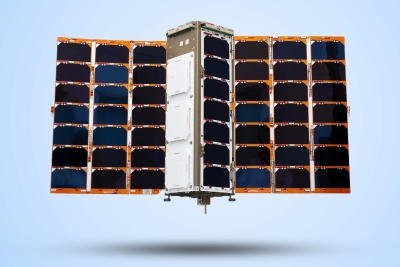- Learn & Discover
- Satellites expand research on ...
Satellites expand research on Space Weather and Sun-Earth Interactions
24 Jan 2023

Space is not a vacuum. It is full of electromagnetic radiation and charged particles and is ever-changing due to unpredictable outbursts from our Sun.
Earth observation data provide vital warnings about the impact of solar activity and strive to unravel the influence the Sun has on Earth’s system.
Copious amounts of radiation and energetic material stream out of the Sun every second. This constantly fluctuating solar wind can be hazardous to space-borne and ground-based infrastructure and causes dynamic changes in the space environment, known as “space weather”. The longer-term impact of solar variability is referred to as space climate.
Scientists rely on data from ESA’s many Earth observation missions to better understand the complex interactions of solar activity with Earth’s magnetic field and its impacts.
Using pioneering space technologies, ESA’s Earth Explorer family of research missions have long contributed to monitoring Earth.
The first such mission, the Gravity Field and Steady-State Ocean Circulation Explorer (GOCE), hosted Fluxgate magnetometers, providing useful magnetic field data for the ionosphere-thermosphere science community.
Scientists have coupled thruster and accelerometer measurements from GOCE with information from its drag-free control system, to create a novel dataset of upper atmospheric densities and wind speeds.
In this way, GOCE’s data - now delivered through ESA’s Heritage Space Programme - provide insights into the impact solar activity has on the upper atmosphere.
The processes deep inside Earth’s core create a powerful magnetic field around Earth, reaching deep into space and shielding the atmosphere from direct exposure to solar wind.
While solar wind interacting with our magnetic field may result in beautiful Aurora displays, solar activity can be hazardous for satellites and infrastructure on ground.
What are the main drivers of space weather?
The main solar activities associated with constantly shifting space weather are solar flares, coronal mass ejections (CMEs) and high-speed solar wind streams. Bright sunspots on our Sun release intense bursts of radiation, known as solar flares. CMEs are large eruptions of plasma and magnetic field and high-speed solar wind can stream out from coronal holes.
Swarm warns about solar hazards as Sun ramps up activity

ESA’s three-satellite Swarm constellation is an operational Earth Explorer tasked with unravelling information about Earth’s magnetic field, studying features from core dynamics to space weather.
All three Swarm spacecraft have together completed more than 100,000 passes over the equator, collecting a huge amount of very precise measurements in the upper ionosphere.
Recent research based on Swarm data has shown that Earth’s magnetic field actively controls how the electromagnetic energy transported during space weather events is distributed into the upper atmosphere.
Their findings show that the seasonally averaged energy input is channelled disproportionally towards the northern hemisphere.
As the Sun is ramping up its activity as part of its approximately 11-year activity cycle - set to peak in the summer of 2025 – Swarm’s contribution to our understanding of magnetic field and solar interactions is more important than ever.
Researchers have recently used approximately seven years of the newly reprocessed 16 Hz Swarm ion velocity data set, along with magnetic field measurements from the mission’s onboard magnetometers, to show that the average space weather input is often underestimated.
Having long baseline measurements and long mission duration is imperative to understanding space climate.
In 2018, Swarm was joined by a fourth spacecraft - CASSIOPE - a Canadian satellite formally integrated into the Swarm constellation under ESA's Third Party Missions (TPM) Programme, as “Swarm Echo”.
CASSIOPE carries a dedicated scientific payload – the Enhanced Polar Outflow Probe (e-POP) probe.
One of the most recognisable impacts of solar activity on Earth’s magnetic field are aurora. The four Swarm spacecraft have been able to examine how fine structure within the aurora are linked to specific waves in Earth’s magnetic field, which power these structures.
Does Space Weather affect Earth weather?
As solar radiation heats the atmosphere it contributes to atmospheric composition and the formation of clouds, storms and rainfall. Atypical dips in solar activity during the Sun’s 11-year old cycle have been linked to warm spells in winter Arctic and weather conditions in Europe. Large solar eruptions have also been linked to changes in Earth’s cloud cover.
SMOS data provide new methods to detect Space Weather events
While ESA’s SMOS satellite has long delivered a wealth of data about soil moisture and salt in the surface waters of the ocean, its data are unexpectedly useful for research in solar activity.
The novel Microwave Imaging Radiometer using Aperture Synthesis (MIRAS) instrument onboard SMOS operates at a frequency of 1.4 GHz in the L-band microwave range of the electromagnetic spectrum.
MIRAS not only picks up faint microwave emissions from Earth’s surface, but also stray signals from the Sun. Extraction of this signal has led to exciting new opportunities within the field of space weather, as recently showcased at the first SMOS Space Weather Workshop.
Researchers showed how SMOS L-band data can be used to retrieve measurements of solar flux and Total Electron Content (TEC) in the ionosphere. SMOS data can even be used to detect space weather events, such as solar radio bursts from solar flares.
As the commercial satellite industry continues to establish large constellations of small satellites and CubeSats in low Earth orbit, there is an increased concern for measurements of thermospheric atmosphere densities along satellite’s orbits.
Does Earth’s magnetic field affect human health?
While the powerful magnetic fields of medical scanners may cause temporary dizziness and nausea, Earth’s weak magnetic field has no effect on human health.
TPM satellites help understanding of Sun-Earth Interaction
In the framework of ESA's TPM Programme, the agency offers access to the full data archives of many of these commercial satellite missions, which are owned by organisations around the world.
Even minor geomagnetic storms may cause atmospheric density perturbations which are dangerous to lower Earth orbit satellites – such as that causing the solar "destruction event" of almost forty Starlink satellites in early 2022.
ESA is implementing a Distributed Space Weather Sensor System (D3S) as a practical means to monitor space weather and warn satellites about impending solar hazards.

The Spire CubeSat constellation is a Third Party Mission Under Assessment. As part of this assessment phase – in the frame of a dedicated Announcement of Opportunity (now closed) – scientists have been allowed access to Spire data for research purposes.
Spire relies on sensors that receive global navigation satellite system (GNSS) signals to provide many space weather datasets.
Spire’s GNSS-R and GNSS-RO satellites take measurements of the reflection or refraction of GNSS signals from Earth, helping create space weather datasets including, total electronic content, ionospheric density profiles and satellite precise orbit determination data, which can be used to infer thermospheric density.
Another TPM, the atmosphere-studying Odin mission is being used to investigate the impacts of a process called energetic particle precipitation, which is strongly influenced by solar activity.
This research – which is currently being completed – aims to explore how the process produces nitrogen oxide in the mesosphere and lower thermosphere which then descends to the stratosphere where it is involved in the depletion of ozone.
The research draws on data from Odin’s Submillimeter Wave Radiometer.
Information about space weather and its influence on Earth’s system - generated by ESA’s Earth observation activities - contributes to protecting many sectors.
Solar hazards can potentially affect space-based telecommunications, weather services and navigation, as well as ground-based infrastructure such as power distribution.
Earth observation data are critical in warning of potentially harmful turbulence in our planet’s star.